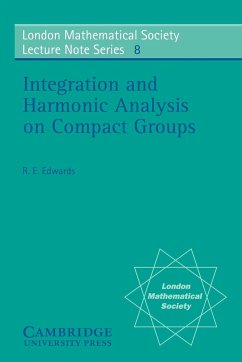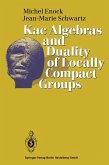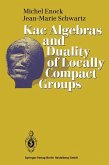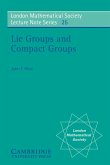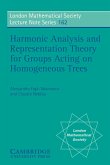- Broschiertes Buch
- Merkliste
- Auf die Merkliste
- Bewerten Bewerten
- Teilen
- Produkt teilen
- Produkterinnerung
- Produkterinnerung
These notes provide a reasonably self-contained introductory survey of certain aspects of harmonic analysis on compact groups.
Andere Kunden interessierten sich auch für
![Kac Algebras and Duality of Locally Compact Groups Kac Algebras and Duality of Locally Compact Groups]() Michel EnockKac Algebras and Duality of Locally Compact Groups77,99 €
Michel EnockKac Algebras and Duality of Locally Compact Groups77,99 €![Compact Lie Groups Compact Lie Groups]() Mark R. SepanskiCompact Lie Groups35,99 €
Mark R. SepanskiCompact Lie Groups35,99 €![Kac Algebras and Duality of Locally Compact Groups Kac Algebras and Duality of Locally Compact Groups]() Michel EnockKac Algebras and Duality of Locally Compact Groups76,99 €
Michel EnockKac Algebras and Duality of Locally Compact Groups76,99 €![Automorphism Groups of Compact Bordered Klein Surfaces Automorphism Groups of Compact Bordered Klein Surfaces]() Emilio BujalanceAutomorphism Groups of Compact Bordered Klein Surfaces39,99 €
Emilio BujalanceAutomorphism Groups of Compact Bordered Klein Surfaces39,99 €![Compact Lie Groups Compact Lie Groups]() Mark R. SepanskiCompact Lie Groups49,99 €
Mark R. SepanskiCompact Lie Groups49,99 €![Lie Groups and Compact Groups Lie Groups and Compact Groups]() John F. PriceLie Groups and Compact Groups58,99 €
John F. PriceLie Groups and Compact Groups58,99 €![Harmonic Analysis and Representation Theory for Groups Acting on Homogenous Trees Harmonic Analysis and Representation Theory for Groups Acting on Homogenous Trees]() Alessandro Figa-TalamancaHarmonic Analysis and Representation Theory for Groups Acting on Homogenous Trees49,99 €
Alessandro Figa-TalamancaHarmonic Analysis and Representation Theory for Groups Acting on Homogenous Trees49,99 €-
-
-
These notes provide a reasonably self-contained introductory survey of certain aspects of harmonic analysis on compact groups.
Produktdetails
- Produktdetails
- Verlag: Cambridge University Press
- Seitenzahl: 192
- Erscheinungstermin: 30. November 2007
- Englisch
- Abmessung: 229mm x 152mm x 11mm
- Gewicht: 287g
- ISBN-13: 9780521097178
- ISBN-10: 0521097177
- Artikelnr.: 23453761
- Herstellerkennzeichnung
- Libri GmbH
- Europaallee 1
- 36244 Bad Hersfeld
- gpsr@libri.de
- Verlag: Cambridge University Press
- Seitenzahl: 192
- Erscheinungstermin: 30. November 2007
- Englisch
- Abmessung: 229mm x 152mm x 11mm
- Gewicht: 287g
- ISBN-13: 9780521097178
- ISBN-10: 0521097177
- Artikelnr.: 23453761
- Herstellerkennzeichnung
- Libri GmbH
- Europaallee 1
- 36244 Bad Hersfeld
- gpsr@libri.de
General Introduction
Acknowledgements
Part I. Integration and the Riesz representation theorem: 1. Preliminaries regarding measures and integrals
2. Statement and discussion of Riesz's theorem
3. Method of proof of RRT: preliminaries
4. First stage of extension of I
5. Second stage of extension of I
6. The space of integrable functions
7. The a- measure associated with I: proof of the RRT
8. Lebesgue's convergence theorem
9. Concerning the necessity of the hypotheses in the RRT
10. Historical remarks
11. Complex-valued functions
Part II. Harmonic analysis on compact groups
12. Invariant integration
13. Group representations
14. The Fourier transform
15. The completeness and uniqueness theorems
16. Schur's lemma and its consequences
17. The orthogonality relations
18. Fourier series in L2(G)
19. Positive definite functions
20. Summability and convergence of Fourier series
21. Closed spans of translates
22. Structural building bricks and spectra
23. Closed ideals and closed invariant subspaces
24. Spectral synthesis problems
25. The Hausdorff-Young theorem
26. Lacunarity.
Acknowledgements
Part I. Integration and the Riesz representation theorem: 1. Preliminaries regarding measures and integrals
2. Statement and discussion of Riesz's theorem
3. Method of proof of RRT: preliminaries
4. First stage of extension of I
5. Second stage of extension of I
6. The space of integrable functions
7. The a- measure associated with I: proof of the RRT
8. Lebesgue's convergence theorem
9. Concerning the necessity of the hypotheses in the RRT
10. Historical remarks
11. Complex-valued functions
Part II. Harmonic analysis on compact groups
12. Invariant integration
13. Group representations
14. The Fourier transform
15. The completeness and uniqueness theorems
16. Schur's lemma and its consequences
17. The orthogonality relations
18. Fourier series in L2(G)
19. Positive definite functions
20. Summability and convergence of Fourier series
21. Closed spans of translates
22. Structural building bricks and spectra
23. Closed ideals and closed invariant subspaces
24. Spectral synthesis problems
25. The Hausdorff-Young theorem
26. Lacunarity.
General Introduction
Acknowledgements
Part I. Integration and the Riesz representation theorem: 1. Preliminaries regarding measures and integrals
2. Statement and discussion of Riesz's theorem
3. Method of proof of RRT: preliminaries
4. First stage of extension of I
5. Second stage of extension of I
6. The space of integrable functions
7. The a- measure associated with I: proof of the RRT
8. Lebesgue's convergence theorem
9. Concerning the necessity of the hypotheses in the RRT
10. Historical remarks
11. Complex-valued functions
Part II. Harmonic analysis on compact groups
12. Invariant integration
13. Group representations
14. The Fourier transform
15. The completeness and uniqueness theorems
16. Schur's lemma and its consequences
17. The orthogonality relations
18. Fourier series in L2(G)
19. Positive definite functions
20. Summability and convergence of Fourier series
21. Closed spans of translates
22. Structural building bricks and spectra
23. Closed ideals and closed invariant subspaces
24. Spectral synthesis problems
25. The Hausdorff-Young theorem
26. Lacunarity.
Acknowledgements
Part I. Integration and the Riesz representation theorem: 1. Preliminaries regarding measures and integrals
2. Statement and discussion of Riesz's theorem
3. Method of proof of RRT: preliminaries
4. First stage of extension of I
5. Second stage of extension of I
6. The space of integrable functions
7. The a- measure associated with I: proof of the RRT
8. Lebesgue's convergence theorem
9. Concerning the necessity of the hypotheses in the RRT
10. Historical remarks
11. Complex-valued functions
Part II. Harmonic analysis on compact groups
12. Invariant integration
13. Group representations
14. The Fourier transform
15. The completeness and uniqueness theorems
16. Schur's lemma and its consequences
17. The orthogonality relations
18. Fourier series in L2(G)
19. Positive definite functions
20. Summability and convergence of Fourier series
21. Closed spans of translates
22. Structural building bricks and spectra
23. Closed ideals and closed invariant subspaces
24. Spectral synthesis problems
25. The Hausdorff-Young theorem
26. Lacunarity.

